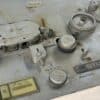Don’t let the past disappear: why analog media belong in your digital transformation strategy
As a data manager, your job is to protect sensitive information, organize critical files, and ensure everything is secure and accessible. You’re focused on digital systems, cloud backups, compliance, and structured data. But what about that shelf of VHS tapes, audio cassettes, or 16mm film reels gathering dust in a back room?
Surprisingly often, we hear data managers admit that these analog formats fall under their responsibility too – yet they’re rarely integrated into the broader data strategy. That oversight risks losing valuable historical records, often irreplaceable, simply because they were stored in outdated formats.

Analog Media is Data – just in another format
Many organizations unknowingly exclude this category. The result? Critical records stay locked in deteriorating formats, inaccessible to modern systems and workflows.
What’s at stake?
Let’s take a look at the kinds of media many institutions have stored away:
- Compliance Recordings: Broadcasters often recorded 24/7 “on-air” signals to VHS for legal and regulatory purposes.
- Plenary Session Archives: Major organizations recorded high-level meetings and assemblies on reel-to-reel audio or VHS-snapshots of historical leadership decisions, policies, and organizational evolution.
- 16mm Films: Once used to document experiments, corporate milestones, or educational content, these reels are often the only visual records of key events.
These recordings weren’t just “nice to have” – they were essential operational records. And today, they’re disappearing because they’ve been left out of the digital strategy.
The silent crisis: Decay and Obsolescence
Magnetic tape degrades. Film shrinks and warps. Legacy equipment to play these formats are increasingly rare, and few people still know how to operate or maintain them. Even when a working machine is available, the expertise to run it may have retired. Without action, these assets risk becoming unplayable – and ultimately, unrecoverable.
Bringing analog Media into the Digital Era
The solution isn’t just digitization. It’s full integration of analog media into your data governance and digital transformation roadmap. Digitizing this media isn’t just about saving it – it’s about making it usable again. Once digitized, analog recordings can be:
- Searched
- Indexed
- Transcribed
- Summarized
- Repurposed
This opens the door to entirely new use cases, from historical research to machine learning, compliance audits, public engagement, and internal knowledge sharing.
Repurposing the Collection: five powerful Enhancements
Once your media is digitized, several tools can radically increase its value:
1. Automatic Indexing
AI tools can auto-tag recordings by speaker, date, topic, or location – making the archive browsable and structurally useful for future applications.
2. Speech-to-Text Transcription
Plenary recordings, interviews, or compliance tapes can be turned into searchable text, increasing accessibility.
3. Text Summarization
Long meetings or lectures can be summarized automatically. Users can scan highlights and skip directly to sections of interest.
4. Searchable Archives
With transcription and metadata, entire archives become searchable. Imagine retrieving every discussion of a policy change across decades with a single query.
5. Custom Reporting
Generate reports based on indexed and transcribed content – perfect for legal reviews, cultural retrospectives, or internal briefings.
These enhancements shift your archive from static storage to a dynamic, searchable, and intelligent knowledge system.
Why this should matter to Data Professionals
You manage your organization’s data estate. That includes all data – whether it’s born digital or recorded on ¾-inch tape.
By integrating analog archives into your data strategy, you gain:
- Historical Insight: Access to decisions and events that shaped your institution.
- Legal Support: Recordings that may serve as evidence or context in regulatory inquiries.
- Cultural Continuity: A deeper understanding of your institution’s evolution and identity.
Losing this media doesn’t just mean lost data—it means erasing part of your organizational memory.
A Practical path forward
Bridging the analog-digital divide doesn’t happen overnight. But it starts with a few clear steps:
- Inventory the Media: Start by identifying legacy carriers – VHS, U-matic, Betacam, reel-to-reel, CD-ROMs, or even floppy disks.
- Secure Equipment: Playback gear is essential, but hard to find. Work with specialists who can restore or supply the right machines.
- Preserve Knowledge: If you still have operators, document their technical knowledge. If not, bring in experts who can train your staff or digitize on your behalf.
- Digitize for Longevity: Professional digitization ensures that signal quality, metadata, and file integrity meet archival standards.
- Repurpose through AI: Use modern tools to unlock searchability, summarization, and content tagging – your archive will become a living resource.
- Integrate into your Data Strategy: Create policies for analog media just as you would for email archives or cloud storage. Include access, security, retention, and compliance.
Bonus tool: Readiness Evaluator
Not sure where to begin? Try an AI-powered Archive Readiness Evaluator. It asks smart, targeted questions about your collection, infrastructure, workflows, and staff expertise. Within 15 minutes, you’ll get a snapshot of where you stand—and what to prioritize next.
➡️ Tip: You’ll need a (free) ChatGPT account to access it.
You’re more than a Data Manager – you’re a Custodian of Memory
Your responsibility doesn’t end at the edge of your server room. Old media hold stories that still matter. Treat them as part of your data ecosystem – not as forgotten relics.
Digital transformation offers a rare opportunity: to save these assets before they’re lost, and to breathe new life into them through modern technology.
Now is the time
Restore the equipment
Preserve the knowledge
Digitize the assets
Enhance the archive
Unlock the past – so it can inform the future.






